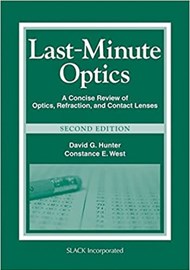For those who shudder at the thought of clinical optics, this is the book for you. Dr Hunter’s second edition of Last-Minute Optics is a resource for more than just last-minute cramming, despite its title. It provides a real-life perspective on optics problems, and its humour keeps it engaging whilst being informative.
This concise book covers key topics in optics, including both theoretical knowledge and clinical applications. The chapters are logical, with earlier topics building on the later material in the book. It covers the science of optics and various lenses, refraction, magnification, prisms, mirrors, low vision aids, common optical instruments, and even refractive surgery.
A question-and-answer format is used throughout the book, which helps breaks difficult concepts up into more manageable sections. This makes it ideal for gaining a deeper understanding of optics, as the same concept is often approached from several different angles. The question format also covers common questions that may arise for those new to the subject.
This book also goes hand-in-hand with Dr Hunter’s excellent four-part clinical optics lecture series, which he updates regularly, with the most recent series released in 2022. The lecture can be found on YouTube, and is an entertaining way of learning optics, whilst the book expands on and tests understanding of the concepts covered.
For those who plan on taking the FRCOphth Part 1 with no prior experience in clinical optics, I would highly recommend watching the lecture series first, then going over this book. Although these two resources are not fully comprehensive for the exam, it does help develop a good fundamental understanding in the topic, and it encourages solving optics questions even when they are asked in different ways. Having a reasonable foundation in optics also makes other higher-level resources more easily digestible and, frankly, more enjoyable.
The most notable highlight of this book is that it is strongly related to actual practice. Each chapter includes questions on clinical scenarios relevant to optics, and the answers explain how to identify the issue, as well as what can be done about them. The final chapter exemplifies this by summating past concepts, and troubleshoots some of the trickiest scenarios that might be experienced in clinical practice.
Overall, this is a book that goes beyond covering optics for optics’ sake. The strength of this book is that it was evidently written with the practising clinician at heart. I would therefore recommend this book to anyone who wants to improve their understanding in optics in order to help their patients.





